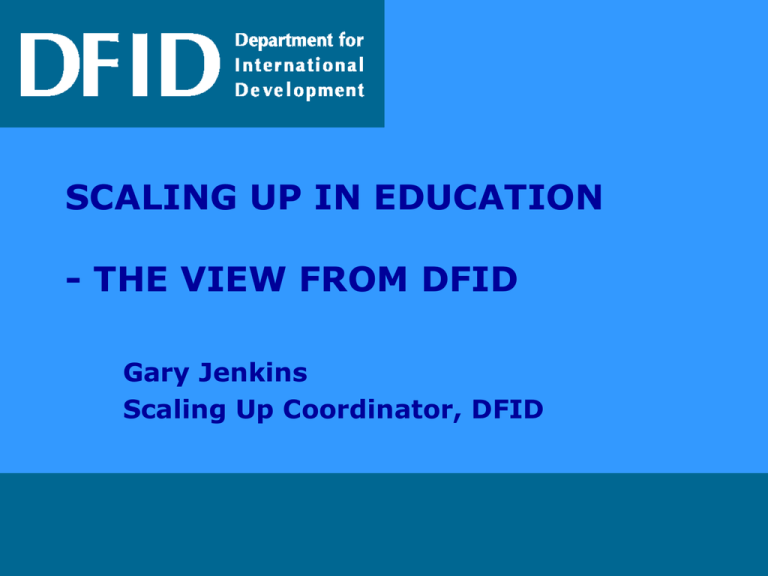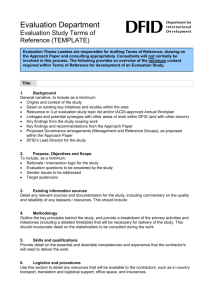SCALING UP IN EDUCATION - THE VIEW FROM DFID
advertisement

SCALING UP IN EDUCATION - THE VIEW FROM DFID Gary Jenkins Scaling Up Coordinator, DFID SCALING UP IN EDUCATION - THE VIEW FROM DFID DFID’s priorities for scaling up Case Study: EDUCATION FOR ALL Translating commitments into action Questions 2 DFID PRIORITIES FOR SCALING UP 2005 - 2015 o use a country-led approach. o deliver long-term predictability as a basis for planning by partner countries. o ensure that fragile states will be included in scaling up and work towards more balanced international aid allocation. o use the scaling up process to increase aid effectiveness (especially predictability, harmonisation/ alignment and accountability). o determine a clearer division of labour between multilateral agencies o collective action to tackle long-term global challenges such as climate change, conflict, pandemic diseases. If ignored, these could undermine efforts to achieve the MDGs. 3 WHAT HAS DFID BEEN DOING SINCE 2005 ? Third White Paper (2006): Making Governance Work for the Poor - - We will increase our budget to 0.7% of GNI by 2013 (0.51% by 2010) We will commit at least half of all future bilateral aid to essential public services: education, health (including HIV+AIDS) water and sanitation, and social protection We will spend at least £8.5 billion on education between 2006 and 2015. New Health Strategy (June 2007) Plans for Water/Sanitation, Aid-for-Trade, Fragile States Work on innovative financing mechanisms (IFFIm, Advance Market Commitments) International coordination: DAC+World Bank meetings Aid allocation …. 4 EDUCATION FOR ALL: THE PROBLEM 77 million primary aged children worldwide not enrolled in schools 44 million (57%) are girls 18 million teachers needed (UNESCO). Plus quality improvements $9 billion additional aid needed to reach MDG. To complete primary school by 2015, must enrol by 2008 5 EDUCATION FOR ALL: DFID SUPPORT Initiative launched in Maputo (April 2006). Follow-up in Brussels “Keeping our Promises on Education” (May 2007) and G8 Summit in Heiligendamm. Country-led: support long-term education sector plans by governments 17 African countries have developed 5-10 year plans for 25 million children Asian and other African countries preparing plans. Predictability: UK will spend £8.5 billion on education 2006-2015 Estimate enough to get 15 million children through better primary schools Fragile states: 5-10 preparing plans. Aid effectiveness: Fast Track Initiative (FTI) supported by 15 donors. Coordinates technical and financial support. Challenges: HIV+AIDS, post-conflict countries, children with disability, gender equality. 6 “RESULTS RESOURCES AND PARTNERSHIP” “Not another donor-driven process!” Country-led process for scaling up Deliver donor commitments at Monterrey, New York, Gleneagles, Barcelona, Paris … Simplify existing processes 7 RRP: WHAT DOES IT MEAN? $m “The first RRPs will test the feasibility of a joint commitment by donors to control total ‘programmable’ aid between specified upper and lower bounds from now to 2015, with firm commitments made for the next 3-4 years” 100 90 80 70 60 50 40 30 20 10 0 Lower Upper Firm Actual 2006 2009 2012 2015 8 RRP: WHAT DOES IT MEAN? A limited number (20-25) of results should be prioritised and defined by partner countries (based on PRS or equivalent strategies) and monitored". " "The RRP process will be country-led and support the Paris Declaration by developing closer donor coordination and harmonisation on key issues, and action on Paris principles that have a local priority.“ "It is envisaged that the RRP process will lead to annual meetings, led by partner governments, at which short documents prepared by the government will be agreed, covering Results, Resources, and actions on Paris principles." 9 QUESTIONS Which DFID priority is most important for developing countries? Is RRP interesting for developing countries? Which aspect of RRP is most important for developing countries? 10






